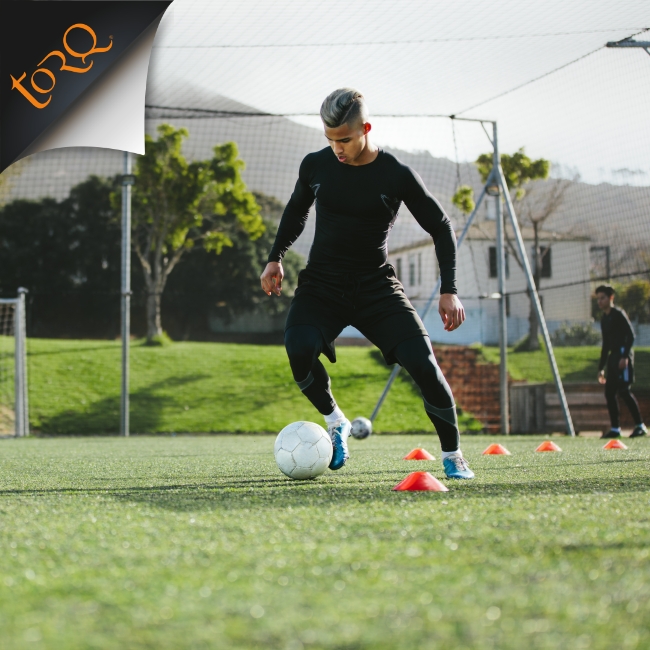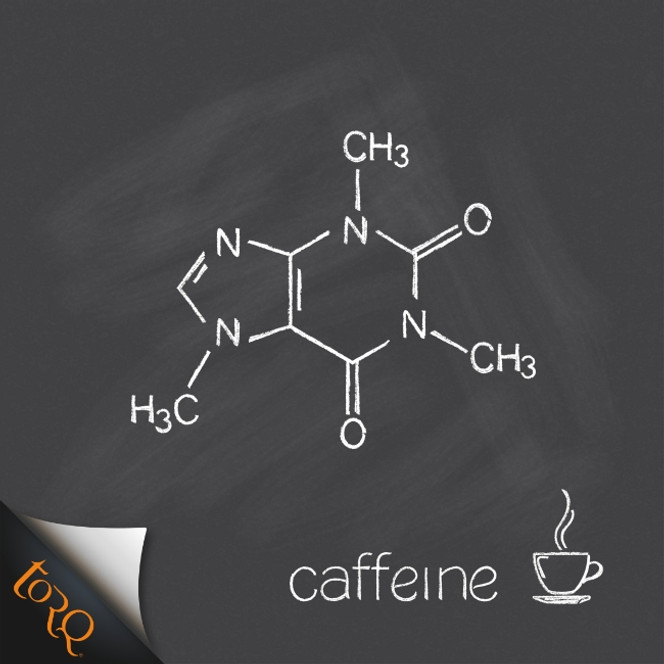What is caffeine, what does it do, how does it enhance sporting performance and when should you consume it for optimal benefits?
Most people recognize that Caffeine is present in coffee, but fewer realize that tea is caffeinated and so too is cocoa. Caffeine is also added as a supplement to certain beverages and foodstuffs, such as commercially available so called ‘Energy Drinks’, many of which paradoxically actually contain little or no energy! Three of TORQ’s Energy Gels contain natural guarana which is highly caffeinated and our Cola Caffeine Energy Drink contains it too.
First and foremost, by definition, caffeine is a drug. A drug is defined as a substance that alters physiological and/or psychological function as a result of ingestion. Caffeine is possibly the world’s most commonly consumed drug substance, estimated to be habitually used by a staggering 90% of the global population. You only have to walk down your local high street to recognize how socially accepted caffeine is within society by counting the number of coffee shops you pass by.

Because caffeine is so socially accepted and almost impossible to regulate, in 2004, the World Anti-Doping Agency (WADA) decided to move caffeine from the ‘Prohibited Substances’ list to the ‘Monitoring Programme’ list, where caffeine would be permitted for use within safe ranges by professional athletes. This would ensure that caffeine, whilst a permitted substance, would not be mis-used or abused within professional sport. WADA deems the abuse of caffeine at urinary concentrations of 6ug/ml urine, which equates to around 9mg/kg of body weight, equivalent to 675mg of caffeine for a 75kg athlete or 8 caffeinated TORQ Gels at the point of sampling. So, it’s fair to say you can consume an exceptional amount of caffeine before WADA will come knocking at your door!
What Does Caffeine Do?
Caffeine has been shown to stimulate and enhance the function of the central nervous system (CNS) along with muscle function via three different mechanisms.
Mobilisation of Calcium: The first mechanism is through increasing the mobilization of calcium within the muscle cells. Our Cramp Paradox article explains in detail the role of calcium on muscle contraction, however, in a nutshell, the greater the amount of calcium available, the more efficient the muscular contraction becomes. Since caffeine mobilises more calcium, it increases the efficiency of muscular contractions.
Blocking Adenosine Receptors: Secondly, caffeine has been shown to bind to adenosine receptors within the brain to keep us focussed and stimulated. Adenosine is largely produced and secreted from the brain, and amongst other significantly important tasks required for survival, it is responsible for the regulation of the sleep-wake cycle working in harmony with the hormone melatonin. When adenosine molecules bind to adenosine receptors in the brain, the highly stimulated central nervous system starts to relax. We typically experience this during the evenings as our bodies start to calm down before going to sleep. When we consume caffeine, the molecules bind readily to the adenosine receptors, preventing adenosine from doing so. Therefore, paradoxically, rather than caffeine actually having a stimulating effect on the brain, it takes up space on receptors so that adenosine isn’t able to bind to them to ‘de-stimulate’ the brain. So caffeine stops the de-stimulation of the brain! The overall impact is the same though – caffeine stimulates the CNS.

Adrenalin Release: Thirdly, caffeine consumption has a stimulating effect of the pituitary glands. These glands are responsible for the release of adrenaline, the hormone responsible for many biological functions, but also largely tasked with the activation of the Sympathetic Nervous System. The sympathetic nervous system is the part of the CNS and it runs automatically and subconsciously without the need for a decision from the brain. The best example of the sympathetic nervous system in action is when you touch a hot stove by accident. Your hand will rapidly move away from the heat before you have even had chance to recognise that you may have been burnt. As the amount of circulating adrenaline increases after caffeine ingestion, it’s easy to understand that the ‘lubrication’ of the sympathetic nervous system increases alertness, reaction time, subconscious decision making, vigilance and psychological arousal.
Caffeine & Fat Mobilisation?
A search of the internet will reveal many articles linking caffeine consumption with the increased mobilisation of free fatty acids – a process called ‘lipolysis.’ The research is clear and it is beyond doubt that caffeine does indeed have this effect, which is linked to the release of adrenalin that we outlined above. However, there seems to be a number of studies that question whether this actually has an ergogenic effect – giving a sporting performance benefit to the individual? The ergogenic benefits from increased fat mobilisation would in theory be in the form of sparing carbohydrate utilisation due to increased fat availability, increasing time to exhaustion/prolonging endurance. We conclude from our thorough review of the literature that benefits are unlikely and perhaps should be considered as a ‘bonus’ rather than being the sole reason for supplementing with caffeine. We believe that much more emphasis should be placed on the enhancements to the CNS discussed above, but to be open minded to the benefits of increased fat mobilisation – perhaps another good reason to supplement with it if you are an endurance athlete.
Individual Caffeine Response
It is very important to recognise that there is a significant inter-person variability with regards to the response caffeine can have on performance. For example, an individual may respond in one of 4 ways; positively, negatively, be a high responder, or a low responder.
A high responder would generally feel a noticeable change from a relatively small dose of caffeine (we explore caffeine dosing in more detail later in this article). On the other hand, a low responder may need significantly more caffeine to notice the stimulatory effects on performance, if they notice any psychological/physiological change at all!
Then there are positive and negative responders. A positive responder may find they have an increased alertness following caffeine consumption, allowing them to complete tasks with less error, resulting in better efficiency. From a physiological perspective, a positive responder may also find that they can hold a higher cycling power output or running pace for a lower rate of perceived exertion. A negative responder may find that consuming a large quantity of caffeine generates greater feelings of anxiety and may experience heightened side-effects of high caffeine consumptions such as physical tremors or “jitters”.
With this in mind, it’s important that you experiment with caffeine during training and identify how you respond and how much you need. From many years of sport and exercise coaching and consultancy experience here at TORQ, we have found the addition of caffeine within people’s nutritional strategies to offer a largely beneficial advantage to those looking to enhance their training and racing performance. At the same time, if you’re usually crippled by pre-event nerves, the timing of your caffeine consumption needs to be carefully considered, because the heightened pre-event anxiety that caffeine might encourage could have a detrimental effect on your performance – far greater than any benefits caffeine might bring to the table.
Caffeine Tolerance & Dependency
It is largely unknown whether the tolerance to caffeine increases as a result of habitual daily caffeine ingestion, however signs of caffeine dependency have been established through research. Research from T.E Graham, (2001) highlighted that some bodily tissues may adapt to frequent caffeine exposure while others may not. As it is not known exactly which tissues adapt to frequent caffeine exposure, it is difficult to determine the effects that long term caffeine ingestion may have on an athlete’s response to caffeine ingestion. In other words, would an athlete who drinks lots of coffee daily respond differently to an athlete who lives on a caffeine-free diet?
Work form Strain et, al. (1994) noted that caffeine dependency is characterised by tolerance to caffeine, consuming caffeine in larger doses along with a persistent desire for caffeine and so on. Strain and colleagues also noted that withdrawal symptoms (lethargy/headaches) from caffeine can be recognised from as little as 3 days of caffeine exposure suggesting that dependancy does occur and does so quite quickly.
Therefore, if you are looking to maximise the advantages of caffeine ingestion, you could consider introducing a 7-day caffeine wash-out phase leading up to a major event, to ensure that you respond maximally to the stimulant during competition. You should however consider how lousy this might make you feel and should certainly practice this ‘wash-out’ regimen with a dry run during training so that you are clear on how your body might respond to it. It may be that it will work better for you to continue your habitual caffeine intake and elevate this intake during competition. The protocols we discuss shortly will indicate how you might go about this – do you wash-out caffeine to increase sensitivity, or simply consume more caffeine during your chosen event?

Caffeine Ingestion For Short Events
Within sport and exercise science research around shorter events, caffeine is most commonly ingested at around 60 -90 minutes pre-exercise. The reason for this is because blood-caffeine concentration reaches its peak around 40–60 mins post ingestion and so this is where the peak performance benefits are likely to occur. This becomes highly relevant to exercise sessions or races that are shorter than 1 hour – events such as a 10-mile cycling time trial or a 5km running race, where the duration would be considered short, but the exercise intensity would be high.
Although consuming caffeine prior to a short event may be considered optimal, as suggested above, this may not be the correct tactic for you if you struggle to remain calm before an event. Consuming a caffeinated energy gel on the start line or caffeinated energy drink during the early stages of the event would still deliver benefits as the caffeine concentrations within the blood would be rising during and peaking towards the end of the event.
Caffeine Ingestion For Endurance Events
Caffeine can also be consumed to alleviate the sensations of fatigue during the final stages of an endurance event lasting longer than 60 minutes. Caffeine ingestion in the latter stages of an endurance effort may offer a considerable advantage over competitors who don’t. Due to the prolonged nature of endurance sports comes the potential of chronic fatigue as the event or training session draws on, resulting in an increased rating of perceived exertion, loss of focus and decline in mood state. This can spiral into an increasingly negative experience with a consequential drop in performance. Caffeine has been proven to reduce the rating of perceived exertion, so can help to blunt this negative psychology. Combined with increases in muscular efficiency driven by caffeine consumption and an increased state of mental alertness, focus and mood elevation, these negative feelings can be quickly turned around.
If indeed caffeine does assist in the mobilization of fat as a fuel source, this too would have an impact on late-stage endurance performance. We would, of course, always recommend following the TORQ Fueling System to ensure that a plentiful supply of carbohydrate exists to fuel performance. To this end, even if the research supported an increase in fat utilization as a result of caffeine intake (and a carbohydrate-sparing effect), these marginal benefits would never replace the significant advantages achieved by fueling properly.

Caffeine Ingestion For Technical Events & Team Sports
Many sports rely on periods of high intensity exercise where perception of exertion, decision-making capabilities and a positive mental attitude will have a significant impact on performance. As physical fatigue kicks in, these psychological attributes will start to decline and clearly a substance like caffeine which stimulates the CNS has a positive role to play.
For example, you may be a mountain biker or have been mountain biking in the past and will be familiar with the difficulties in making the correct line choices as you start to fatigue. At the start of your ride, you will be looking way up the trail, 10 meters ahead or beyond, observing roots, narrow gaps and drop offs. However, as you start to fatigue, you notice that your gaze begins to struggle to look further than a couple of meters ahead of you and as a result, you will start clumsily crashing into things you would otherwise have avoided.

In the case of Mountain Biking, staying sharp is imperative, not only saving you valuable seconds on the course through taking smooth line choices, but also making you less vulnerable to crashing, punctures and mechanical mishaps. The same principle of course would apply to trail running or adventure sport competitions.
The ability of caffeine to ‘lift your mood’ through the stimulation of the CNS cannot be underestimated either when considering technical sports. As discussed above, this is of particular importance in endurance events where fatigue progression in the latter stages of an event or training ride can be quite tough to deal with psychologically. Caffeine’s ability to stimulate the CNS to increase focus and make things feel easier (reduced perception of exertion) will lift your mood and provide you with what’s often referred to as ‘second wind’ and an ability to make the correct positive choices.
If we consider caffeine supplementation from a team sports perspective, football for instance involves 90 minutes of explosive intermittent sprint exercise, which has the capacity to cause neuromuscular fatigue over the duration of the match. This is because these efforts require high muscular force to move the footballer from A to B as quickly as possible and the repeated demand on the CNS to send electrical ‘action messages’ to the working muscles ultimately results in fatigue at a central level. Remember how we mentioned calcium earlier and the role it plays in promoting muscular efficiency? By making these pools of calcium readily available, caffeine has a direct physiological role to play in addressing this form of fatigue.

Optimal Caffeine Dosing
With so many variables being at play, we have done our best to put a guide together for you based on our interpretation of the research. For example, research from Kovacs and colleagues found that caffeine ingestion improved 1 hour cycling time trial performance in well trained athletes. Within this study, participants consumed a carbohydrate and electrolyte beverage with 75mg/500ml, 112mg/500ml or 160mg/500ml of caffeine and found that supplementation improved cycling time trial performance in all caffeine trials against a non-caffeinated placebo. The greatest time trial performance advantage was noted in the 112mg/500ml (medium dose) trial suggesting ‘more is not always better.’
Research from both Kovacs and colleagues (1998) and Desbrow et al., (2012) noted that higher levels of caffeine offered no further performance advantage over medium or moderate caffeine intakes. In these studies, the medium – moderate values were considered at 112mg/500ml and 3mg per kg bodyweight respectively. This would suggest that the optimal pre-exercise caffeine dose should be between 89–159mg of caffeine, consumed 40minutes before the desired time point, allowing the blood caffeine concentration to reach it’s peak.
However, neither of these studies considered whether the participants in the study were high or low responders to caffeine (sensitive or insensitive to it) or to what extent they habitually consumed caffeine, if it all.
So, first of all, you need to decide whether you are a high, medium or low responder to caffeine. It’s likely that if you don’t habitually consume caffeine, you will be a high responder and if you drink multiple coffees in a day, you will be a low responder. If you are a high responder, it’s vital that you practice caffeine use during training and give careful consideration as to whether stimulation of the CNS will be useful to you prior to an event. If you usually feel sleepy and lethargic on event day, it may be the perfect supplement, but this probably won’t be the case if you suffer from pre-event anxiety.
Use the following table as a guide to help you with your caffeine dosing:
| Caffeine Sensitivity | Exercise Duration | Caffeine Timing | Caffeine Dose | Total Caffeine Consumed* |
|---|---|---|---|---|
| High Responder | Up to 1 hour | 40-60mins pre-exercise or at start of exercise | 80-100mg | 80-100mg |
| High Responder | Up to 3 hours | Caffeine @ 1.5 hours into exercise | 80-100mg | 80-100mg |
| High Responder | Beyond 3 hours | Caffeine every 2 hours | 80-100mg | 80-100mg per 2 hours** |
| Medium Responder | Up to 1 hour | 40-60mins pre-exercise or at start of exercise | 80-100mg | 80-100mg |
| Medium Responder | Up to 3 hours | Caffeine @ 1 and 2 hours into exercise | 80-100mg | 160-200mg |
| Medium Responder | Beyond 3 hours | Caffeine every 1.5 hours | 80-100mg | 80-100mg per 1.5 hours** |
| Low Responder | Up to 1 hour | 40-60mins pre-exercise AND at start of exercise | 80-100mg | 160-200mg |
| Low Responder | Up to 3 hours | Caffeine @ start plus 1 & 2 hours into exercise | 80-100mg | 240-300mg |
| Low Responder | Beyond 3 hours | Caffeine @ start & then every hour | 80-100mg | 80-100mg @ start & hourly thereafter** |
*Caffeine to be taken in addition to habitual tea/coffee consumption.
**Caffeine intake doesn’t need to take place within the last hour of exercise.
TORQ Cola Caffeine Energy Drink (With Guarana): 100mg Caffeine per 500ml
TORQ Banoffee Energy Gel (with Guarana): 89mg Caffeine per Gel
TORQ Caramel Latte Energy Gel (with Guarana): 89mg Caffeine per Gel
Conclusion
To bring this stimulating topic to an end, the effect of caffeine on sports performance has been shown to offer largely beneficial effects by stimulating the CNS and improving muscle efficiency in both shorter and more endurance-based events. Benefits have also been noted in technical and team sports. Caffeine may help to mobilize fat as fuel source during endurance exercise, but expert opinions are divided on whether performance benefits exist.
We have put together a protocol for recommended caffeine dosing based on our interpretation of the available research. It is important to establish whether you are a high or low responder before considering your caffeine supplementation strategy and choose the timing of your supplementation to ensure that the caffeine serves to maintain or pick up CNS activity to an optimal level, or whether over-stimulating the CNS at certain times may be disadvantageous. Practice dosing during training is highly recommended.
References
Aguilar-Navarro, M., Muñoz, G., Salinero, J.J., Muñoz-Guerra, J., Fernández-Álvarez, M., Plata, M.D.M. and Del Coso, J., 2019. Urine caffeine concentration in doping control samples from 2004 to 2015. Nutrients, 11(2), p.286.
Gilliland, K. and Bullock, W., 1984. Caffeine: A potential drug of abuse. Advances in alcohol & substance abuse, 3(1-2), pp.53-73.
Pickering, C. and Kiely, J., 2018. Are the current guidelines on caffeine use in sport optimal for everyone? Inter-individual variation in caffeine erogenicity, and a move towards personalised sports nutrition. Sports Medicine, 48(1), pp.7-16.
Strain, E.C., Mumford, G.K., Silverman, K. and Griffiths, R.R., 1994. Caffeine dependence syndrome: Evidence from case histories and experimental evaluations. Jama, 272(13), pp.1043-1048.
Desbrow, B., Biddulph, C., Devlin, B., Grant, G.D., Anoopkumar-Dukie, S. and Leveritt, M.D., 2012. The effects of different doses of caffeine on endurance cycling time trial performance. Journal of sports sciences, 30(2), pp.115-120
Kovacs, E.M., Stegen, J.H. and Brouns, F., 1998. Effect of caffeinated drinks on substrate metabolism, caffeine excretion, and performance. Journal of Applied physiology, 85(2), pp.709-715
Pomportes, L., Brisswalter, J., Hays, A. and Davranche, K., 2019. Effects of Carbohydrate, Caffeine, and Guarana on Cognitive Performance, Perceived Exertion, and Shooting Performance in High-Level Athletes. International journal of sports physiology and performance, 14(5), pp.576-582.
De Pauw, K., Roelands, B., Knaepen, K., Polfliet, M., Stiens, J., & Meeusen, R. (2015). Effects of caffeine and maltodextrin mouth rinsing on P300, brain imaging, and cognitive performance. Journal of Applied Physiology, 118(6), 776–782. https://doi.org/10.1152/japplphysiol.01050.2014
Graham, T.E., 2001. Caffeine and exercise. Sports medicine, 31(11), pp.785-807.
Graham, T.E., Hibbert, E. and Sathasivam, P., 1998. Metabolic and exercise endurance effects of coffee and caffeine ingestion. Journal of Applied Physiology, 85(3), pp.883-889.
Hodgson, A.B., Randell, R.K. and Jeukendrup, A.E., 2013. The metabolic and performance effects of caffeine compared to coffee during endurance exercise. PloS one, 8(4), p.e59561.
Graham, T.E. and Spriet, L.L., 1991. Performance and metabolic responses to a high caffeine dose during prolonged exercise. Journal of applied physiology, 71(6), pp.2292-2298.
Spriet, L., MacLean, D.A., Dyck, D.J., Hultman, E., Cederblad, G. and Graham, T.E., 1992. Caffeine ingestion and muscle metabolism during prolonged exercise in humans. American Journal of Physiology-Endocrinology And Metabolism, 262(6), pp.E891-E898.
Ramírez-Maldonado, M., Jurado-Fasoli, L., Del Coso, J., Ruiz, J.R. and Amaro-Gahete, F.J., 2021. Caffeine increases maximal fat oxidation during a graded exercise test: is there a diurnal variation?. Journal of the International Society of Sports Nutrition, 18(1), pp.1-9.

